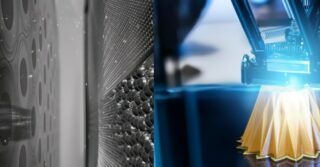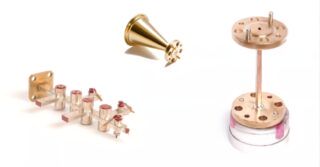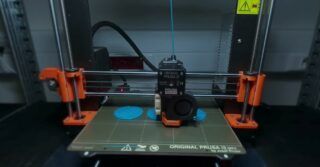Modern materials are expected to operate under extreme load and temperature conditions, often in very unfavourable environments. This creates the need to use new materials with higher strength parameters or to modify the properties of traditional materials in order to meet these expectations.
Growing customer expectations and fierce competition also play an important role, forcing companies to increase the efficiency of production and adapt some products by designing them according to the needs of a particular customer. This, in turn, often involves attempts to introduce new technological solutions to the market that can meet the needs of the most demanding applications and thus provide a market advantage.
SPS/FAST Technology
In the case of materials, the greatest potential currently lies in shaping the structure of the material on a nanometric scale. This is provided by solutions based on powder consolidation using technology that uses electrical impulses for sintering. SPS (Spark Plasma Sintering) technology allows materials to be sintered at lower temperatures than other solutions, significantly reducing or even eliminating grain growth in the material. This technology has been known for many years, but it is only now, largely due to the capabilities of modern technology, that it is showing its extraordinary capabilities in the design and manufacture of advanced materials suitable for the most demanding applications.
The term “spark plasma sintering” is commonly used, but it is quite confusing, as neither spark nor plasma are present in the process, which has been confirmed experimentally. In this respect, the term “Field Assisted Sintering” is more appropriate.
The main feature of FAST is that the pulsed DC current passes directly through the graphite matrix and, in the case of conductive samples, also through the powder. This allows the material to be heated with Joule heat which, unlike traditional sintering techniques, allows a density close to or equal to the theoretical density at a much lower sintering temperature. This is because the heat is generated within the material and is not transferred indirectly through heating elements as in conventional hot pressing.
This solution allows a very high heating rate of up to 1000℃/min to be achieved, resulting in a very fast sintering process lasting from a few to several minutes, depending on the material and sample diameter. Such a fast process ensures that powders are compacted into nano-grids or nano-structures while avoiding the thickening that occurs with conventional sintering methods. This makes FAST technology a very good method for producing materials based on nanoparticles.
U-FAST Technology
GeniCore has developed a sintering machine using FAST technology, which owes its name U-FAST (Upgraded Field Assisted Sintering Technology) in part to an improved power supply system that allows it to generate current pulses of less than a millisecond.
This solution makes it possible to produce materials more efficiently and economically than competing methods. It is currently the only solution in the world that also allows very precise determination of the energy values delivered to the material, enabling very accurate control of the process.
This has a significant impact on the results, as evidenced by the properties of the materials produced by this method. It is also important to note that the materials are formed without the need for pre-pressing, isostatic compaction or drying.
Examples of materials made of U-FAST
U-FAST sintering technology, one of the most advanced powder consolidation techniques, can be used to produce a wide range of materials. These include:
- Carbide is used in the cutting tool industry, structural components and as a matrix material for powder presses. This is due to a combination of desirable properties such as high hardness and mechanical strength. Carbide cutting elements are typically produced by methods such as hot pressing (HP) and hot isostatic pressing (HIP). However, these methods have many disadvantages, such as low speed and long sintering time, high equipment costs and high operating costs. From this perspective, sintering using FAST techniques is a more advantageous solution.
Tungsten carbide was sintered as an example of a sintered carbide. The sintering of WC was carried out using powder with an average grain size of 0.65 μm, containing inhibitors and with the addition of 10% cobalt.
The material obtained has a hardness of 1800 HV and a density of 99.8-100% relative to the theoretical density, carried out at temperatures of 1100-1220°C. The resulting material is characterised by high microstructural uniformity. The grains have not undergone any unfavourable growth after the sintering process, as shown in the figure below.

Microstructure of sintered carbide WC10Co
It is known from the literature that materials with such high densities can only be obtained using WC powder without the addition of inhibitors as the starting powder. The disadvantage of not using this type of additive is unfavourable grain growth. Until now, it has been possible to obtain a material with a density of just over 99% for a WC grain size of 10 nm using WC powder containing an inhibitor (Materials and Manufacturing Processes, 30: 327-334, 2015), which is much lower than the values for materials produced using the U-FAST device.
The GeniCore device is equipped with a pyrometer that operates over the full range of RT-2500℃, making it possible to produce materials that require the application of low temperatures for sintering. Examples include thermoelectric materials and metallic glasses.
- Thermoelectrics (PbTe) – Thermoelectric technologies are based on the direct conversion of waste heat to electrical energy and vice versa. Thermoelectric generators are used, for example, to convert power in “silent” nuclear submarines, to cool power transformers or air conditioning modules, as micro-generators to power sensor systems, or as Peltier elements to cool microprocessors. PbTe compounds are popular thermoelectric materials because they have many desirable properties, including isotropic morphology, high crystalline symmetry, low thermal conductivity and the ability to control carrier concentrations.
Sintering of lead telluride was carried out by running processes for 5 minutes at a temperature of 400°C. Depending on the powder preparation conditions, materials with densities in the range of 98.8-100% of the theoretical density were obtained. This parameter translates into favourable thermoelectric properties, as thermal and electrical conductivities, as well as the Seebeck coefficient, are strongly dependent on the microstructure of the material.
- Metallic glasses (Zr-Cu-Al-Nb) (bulk metallic glasses) are available in a wide range of compositions. They have superior mechanical and chemical properties compared to conventional metals and alloys due to their amorphous structure. As a result, they are considered to be the next generation of high strength materials. They also exhibit very high tensile yield strength (1.9 GPa), elastic elongation (2%), hardness (600 HV) and corrosion resistance. However, BMGs are difficult to produce due to the relatively high cooling rates required for amorphous solidification. Metallic glasses can be used in many areas of engineering, for example as foams in the construction of future spacecraft for long-duration space travel or in medicine.
Sintering was carried out using a powder mixture in the Zr-Cu-Al-Nb system. As a result, after the process at a temperature of 420°C, a material with a density greater than 99% of the theoretical density was obtained. It is characterised by the uniformity of its microstructure and, most importantly, XRD measurements did not show the presence of any crystalline phase.

Sintering in Zr-Cu-Al-Nb system / Bulk Metallic Glasses
It is known from the literature that sintering processes in the same Zr-Cu-Al-Nb system using a different device have not yet succeeded in producing an amorphous material with a density close to the theoretical value (Journal of Alloys and Compounds, vol. 667, 2016, pp. 109-114).
- Composite materials are currently the most numerous group. These include ceramic-ceramic, ceramic-metal and metal-metal composites, as well as their combinations with polymers. The search for new materials that meet ever more stringent parameter requirements continues, leading to the discovery of new areas of application. The U-FAST machine can successfully produce various composites, regardless of their classification.
Tungsten-silver composites, known for their high resistance to arc erosion and high resistance to sintering, are used for electrical contacts in various applications such as electrical switches, contactors, circuit breakers, voltage regulators, arc points and relays. This material is produced by infiltration of a tungsten skeleton or by powder metallurgy, but additional rolling is applied to increase densification. It is commercially available in a 50W-50Ag version with a density of 13.15 g/cm³ (http://www.stanfordmaterials.com/Tungsten-silver.html).
Sintering of tungsten with silver added in a 50/50 ratio has been carried out at a temperature of 900°C. The resulting material has a hardness of 1.0 GPa and a density of 13.40 g/cm³, exceeding the density of the material available on the market. In addition, the manufacturing process involves filling the matrix with a mixture of tungsten and silver powders and sintering without any additional steps, infiltration or rolling.
Composite materials in the zirconia (TZP) – aluminium oxide (α-Al2O3) system exhibit good mechanical properties (strength, hardness) and very good abrasive wear resistance in various environmental conditions. They are used as universal structural ceramics in many technical applications. Al2O3 and ZrO2 are materials with low reactivity compared to metals or polymers, making them suitable for use as bioceramics. Such composites are non-toxic and non-allergenic which, combined with excellent tribological properties, makes them suitable for use in endoprostheses.
U-FAST technology was used to produce a 1:1 volume ratio composite. Sintering at 1400°C resulted in a material with a uniform microstructure and pronounced phase interpenetration. As shown in the SEM image, the technique used allows the grain size of the feedstock powder to be maintained, which is not possible with other sintering methods. This composite is characterised by a density of 99%, a hardness of almost 18 GPa and a resistance to brittle fracture of 9,5 MPa・m0.5.

Composite microstructure 50%Al2O3-50%ZrO2
- Ceramic materials are attractive structural and functional materials of great importance in engineering due to their corrosion resistance, ability to operate at high temperatures and mechanical properties.
Aluminium oxide has many interesting properties such as high strength, high hardness and excellent corrosion resistance. In its transparent form it can therefore be used as electromagnetic windows, transparent armour or covers for metal halide lamps. Sub-micron sintered Al2O3 ceramic is the hardest of all transparent materials. Transparent polycrystalline alumina is therefore seen as a promising alternative to sapphire. It is traditionally produced by sintering in hydrogen at temperatures above 1700°C.
Ceramic transparent material produced using U-FAST technology is characterised by a high degree of sintering, 99.9% of theoretical density and a hardness of HV 2220. In the wavelength range of 3.5-5 µm, the transmission value is at least 80%, which is comparable to commercially available crystals. The sintering process was carried out at temperatures in the range of 1100-1200°C, using a classical graphite configuration and commercial high purity alumina powder. No additional technological steps were taken that would increase production costs.
- Biomaterials. Research (Biomedical Journal of Scientific & Technical Research, 10.26717/BJSTR.2019.23.003952) has resulted in a perfectly dense (100% of theoretical density) titanium material, popular alloys and composites. Mainly because of its biocompatibility and resistance to corrosion in body fluids, titanium is used in medicine for implants, stents and prostheses. However, the main disadvantage of titanium, apart from its high production costs, is its relatively low wear resistance. Titanium metal matrix composites (TMMC) are increasingly being used to overcome this drawback.
The U-FAST sintering technology has been used to obtain (Ti,Mo)C/C materials at a temperature of 1050°C in a sintering time of 2 minutes. The materials obtained are characterised by a hardness of 1580 HV, which is almost 800% higher than that of pure titanium. Thus, the U-FAST technology is useful for the production of titanium-based biomaterials and can contribute to the development of materials with even more favourable parameters.








